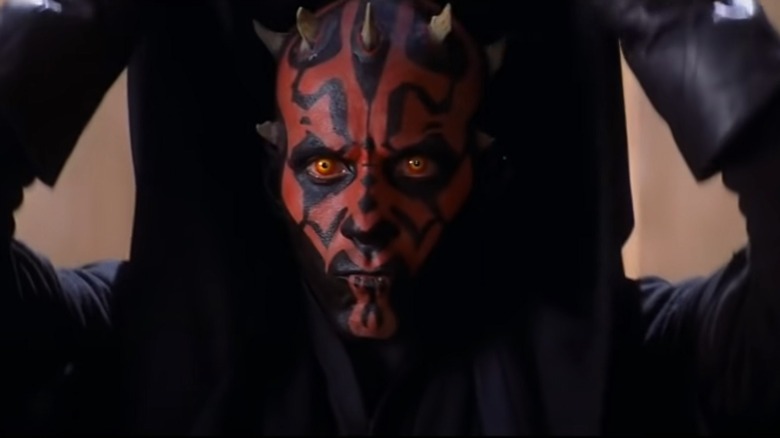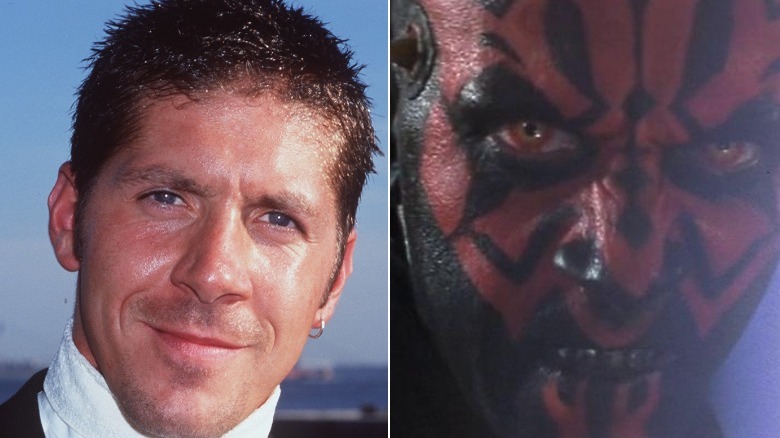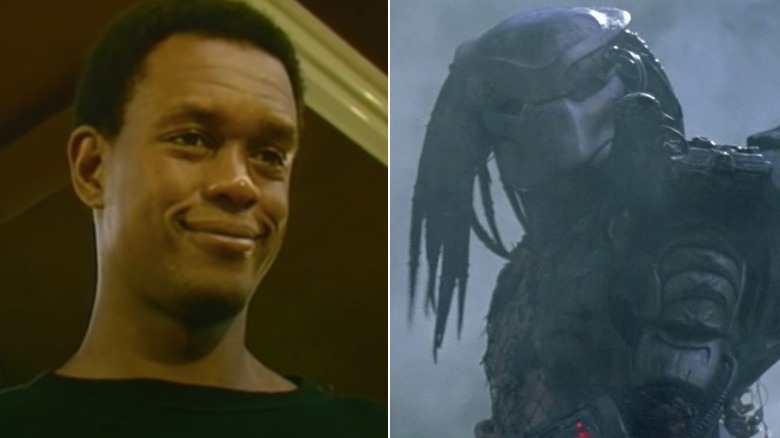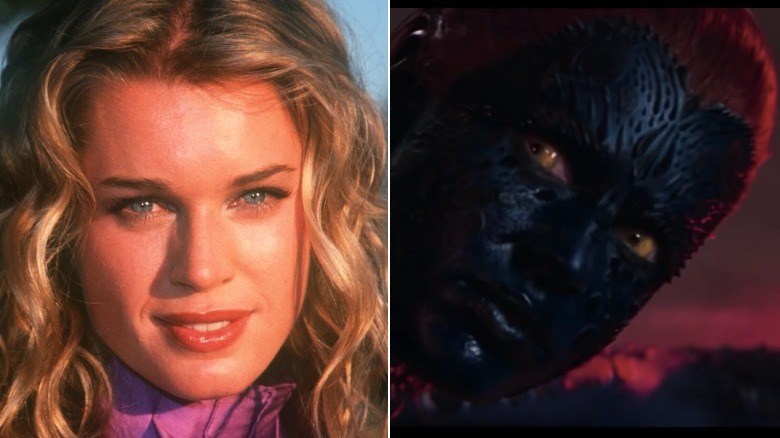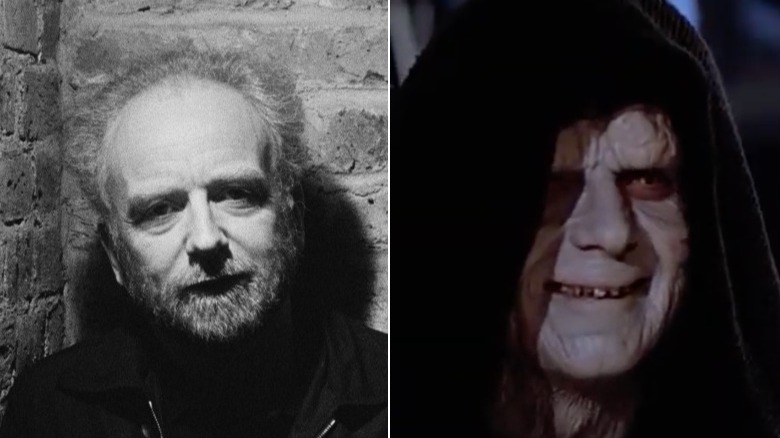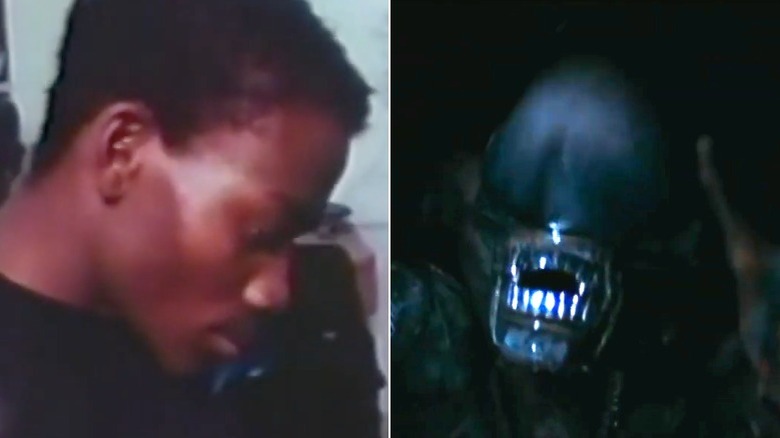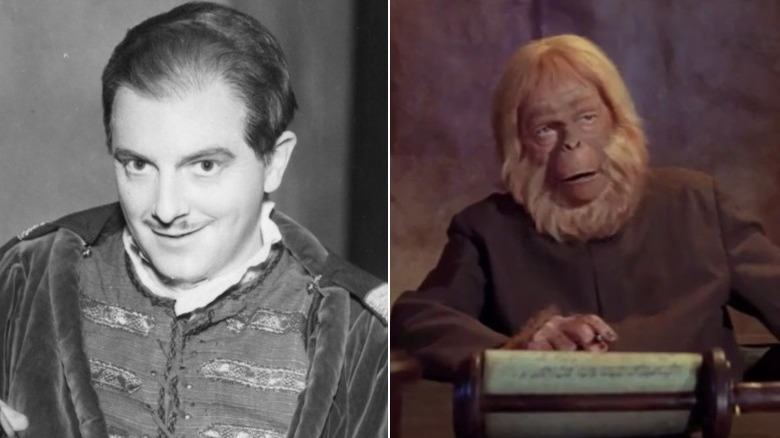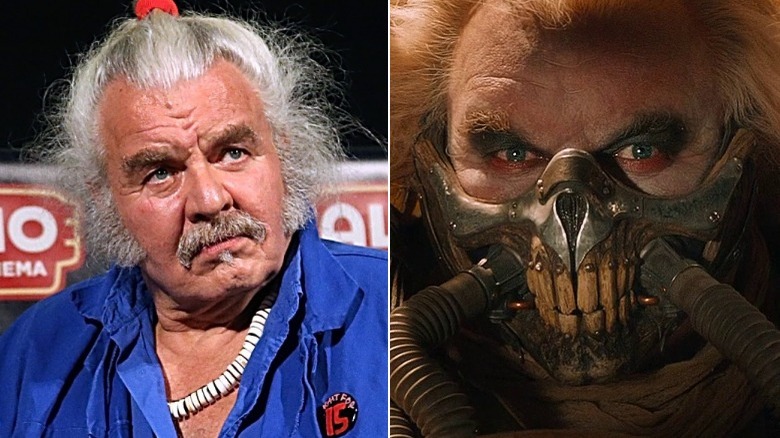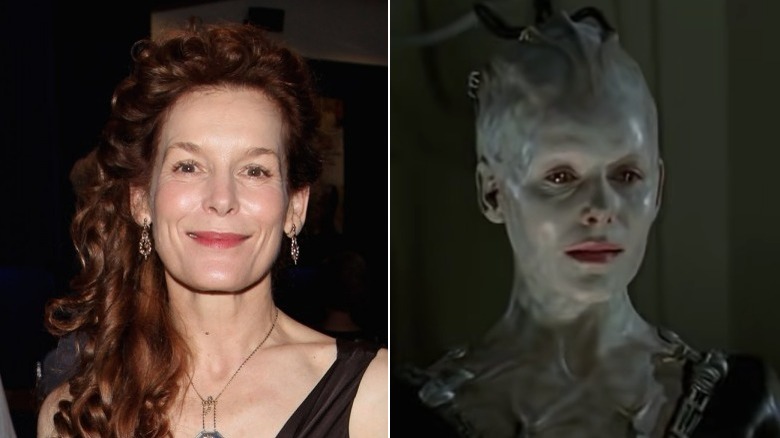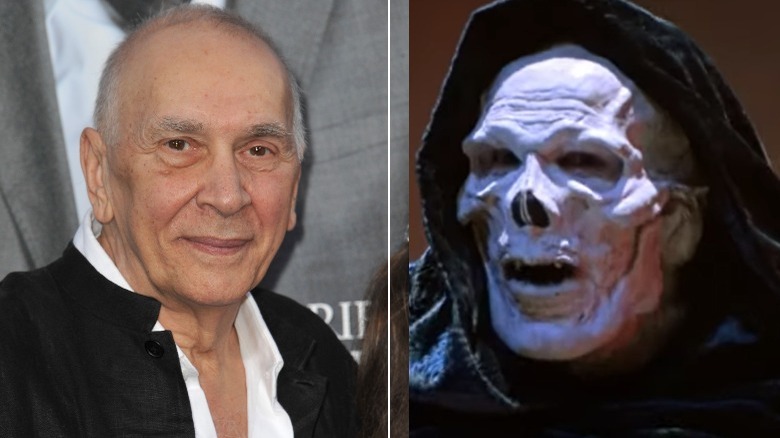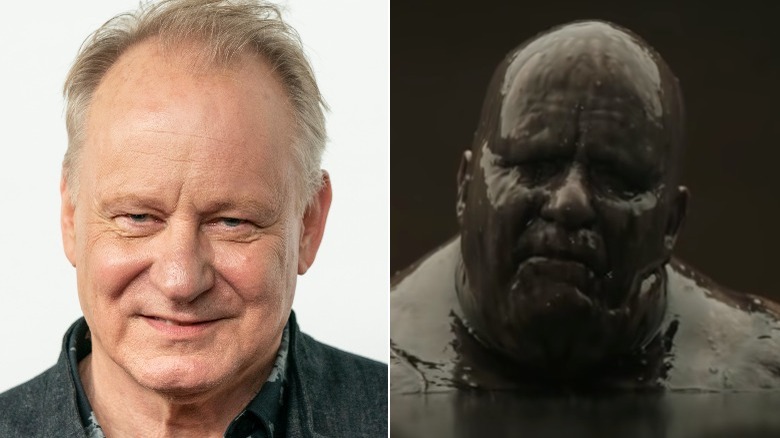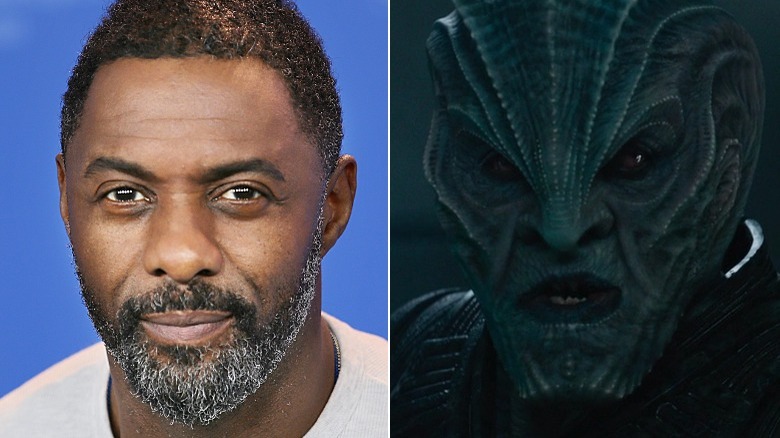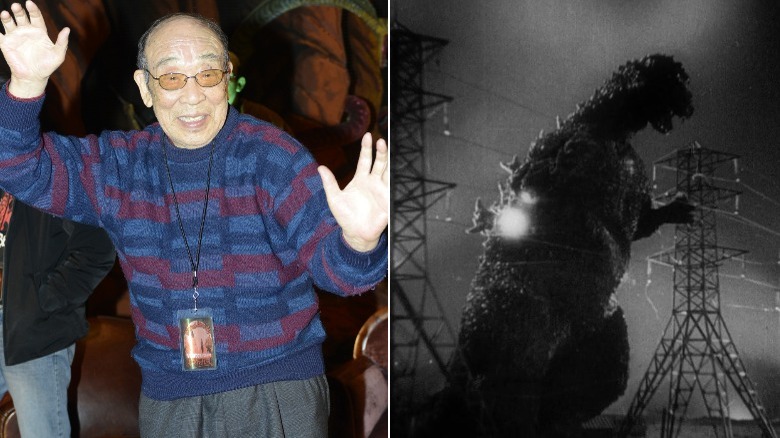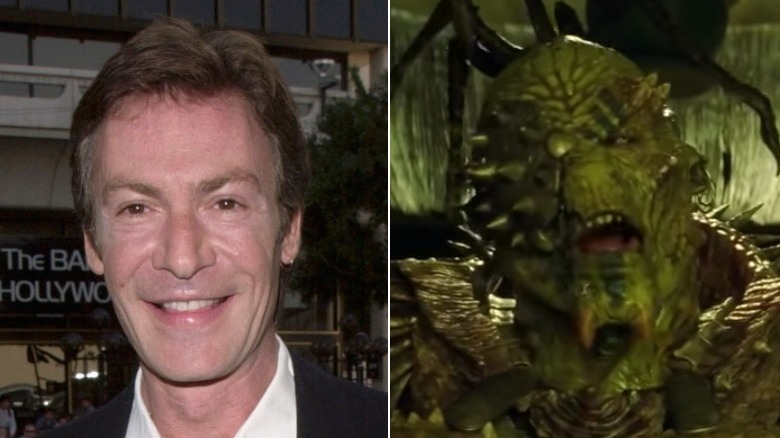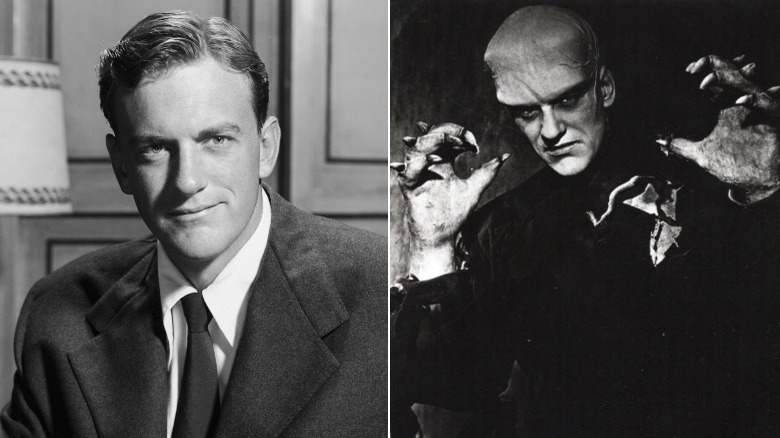The Biggest Villain Makeup Transformations In Sci-Fi History
Science fiction is a special genre. Real human stories are told through the lens of the fantastical. It's a style of storytelling that not only allows the audience to escape their everyday lives, but it gives filmmakers and creative teams room to experiment, flex their skills, and push the boundaries of visual possibilities. Exaggerated, often dystopian worlds are like a giant sandbox in which you can do anything and let your inspiration guide the story at hand.
Set design, costumes, hair, and makeup have proven to be essential puzzle pieces in a much larger picture. Each is as vital to the overall aesthetic and story as the script and performances. Throughout cinema history, the genre has relied on these visual effects to complement the story. Without even one, for example, makeup, the characters might be distracting, leaving the audience unable to suspend disbelief. Whether we're discussing a film's main protagonists or the otherworldly villains, makeup works in tandem with an actor's ability to sell a performance and has frequently resulted in unbelievable physical and emotional transformations.
Going back as far as the silent era and early talkies, science fiction films have boasted some true marvels in special makeup effects. It's difficult to narrow down a definitive list, but here, we celebrate 14 of the best sci-fi villain transformations. You have to see 'em to believe 'em.
Darth Maul
On the set of "Star Wars: Episode I – The Phantom Menace," chief make-up artist Paul Engelen concerned himself mostly with creating Darth Maul, portrayed by Ray Park. He was tasked with developing other characters, including Qui-Gon Jinn (Liam Neeson), but Maul is arguably the pinnacle of the work. Initially, Engelen based early ideas on Doug Chiang's concept drawings.
Artist Ian McCaig was also approached about sketching concept art. Once director George Lucas suggested creating an image worthy of his worst nightmares, McCaig immediately knew what to do, so he crafted an early drawing that was "a cross between a ghost and a serial killer staring in at you" during a rainstorm. It wasn't exactly what Lucas was looking for, so McCaig scaled back and veered into "a mythological" direction. He soon arrived upon what would become the iconic image.
Through further creative back and forth with Lucas and creature effects supervisor Nick Dudman, Engelen sculpted a unique vision for the character and used a mix of a red water-based aquacolor and a Reel tattoo black (with additional pigment). If necessary, he rolled the thick, black mixture onto the back of Park's head before using a paintbrush to blend. When the coloring was set, it was time to cast the horns at Dudman's workshop 一 only after Dudman mistook black feathers for horns. The last elements were pretty simple. Contact lens and silver stud earrings complete the villainous look.
Predator
The development of the 1987 sci-fi film's titular character is complicated, to say the least. Originally, Jean-Claude Van Damme was hired to play the alien creature, but a series of miscommunications lead him to believe he would be showcasing his martial arts skills on screen. But that was simply not true.
Makeup FX artist Steve Johnson first came aboard to re-conceptualize early drawings and create something that worked artistically and would be manageable during filming in Mexico. Instead of "backward-bent reptilian legs, extended arms, and a head that was out here," as Johnson described it, production opted for a red cloaking device. Needless to say, Van Damme was none too happy and early shooting days were insufferable for all involved. Two weeks later, the entire idea was scrapped, and filming shut down for a month so the monster could be entirely redesigned.
Enter Stan Winston. Upon reading the script, the artist determined the Predator needed to be "a real character, rather than a generic creature." A painting hanging in Joel Silver's office proved to be the creative inspiration he needed, and he began sketching an alien creature "with quills that in silhouette would look like dreadlocks." Upon a suggestion from Jim Cameron, Winston added the identifiable mandibles and fleshed out his drawings.
Kevin Peter Hall was then hired to take on the role. In the end, it's all for the best, as his seven-foot-four frame presents a worthy adversary to Arnold Schwarzenegger's imposing physique.
Mystique
Rebecca Romijn first played the mutant shapeshifter Mystique in 2000's "X-Men," and went on to two more sequels, "X2" and "X-Men: The Last Stand." From the outset, it was clear the makeup process was "no joke," as the actor reflected around the first film's 20th anniversary. "I realized pretty early on that was the job. I was getting paid to be a part of that makeup application," she said. In the sequels, Romijn noted the makeup time became "a little less," and she wasn't required to wear contacts as she did in the first film.
With special makeup designer Gordon Smith at the helm, Romijn underwent a grueling "seven to eight hours of makeup every day," she stated at the time. Two-thirds of her body was wrapped in various self-sticking prosthetics, including an upper-back piece, and "the rest was all airbrushed." According to Smith, the prosthetics were "a brand new technology" and "not something anybody's ever tested before."
Mystique was first introduced in a 1978 issue of the "Ms. Marvel" comic. The onscreen adaptation remains pretty faithful to the source material while taking obvious creative license to expand on the image.
Emperor Palpatine
There are few film roles played by the same actor spanning decades. You can count Emperor Palpatine, portrayed by Ian McDiarmid, as one of the rare ones. He first played the iconic "Star Wars" villain in 1983's "Return of the Jedi" (the character was played by Marjorie Eaton and voiced by Clive Revill in "The Empire Strikes Back," although an edit to the film for its 2004 DVD release added McDiarmid to the scene), though the character is first mentioned in the 1977 original, albeit only as the Emperor. McDiarmid's Palpatine appears in all three trilogies at varying ages, but everyone likely knows the classic decrepit look of the character most.
Requiring a latex prosthetic, McDiarmid underwent four hours of makeup every day before filming and "two hours to get it off because they had to be very careful not to take my skin off with the latex," he explained during a panel appearance. As work continued, the process "got faster." In 2005's "Episode III: Revenge of the Sith," for example, the creative team (headed by Dave Elsey and Nikki Gooley) used a different method. "It was a bit like a balaclava," he said. A balaclava is essentially hoodlike headgear that's easily worn and removed. "I thought it was good but not quite as detailed."
"The Rise of Skywalker" saw a return of more detailed makeup, borrowing elements from Nick Dudman's original ideas in the first films. Amanda Knight and Neal Scanlan approached the look by "manipulating bits of my face." In an interview with Collider, Scanlan walked through the process of using old-age stipple, prosthetic, silicon pieces (instead of foam), and sculpting "them as closely as we possibly could to what Nick had created."
Alien
Hans Rudolf Giger was one of the most influential artists in the sci-fi world. A Swiss artist best known for his biomechanical style, Giger released a collection of his works in the 1977 book "Necronomicon." Director Ridley Scott and screenwriter Dan O'Bannon were entranced by two paintings, in particular, "Necronom IV" and "V," and used these to create the xenomorph in their landmark 1979 film, "Alien."
Giger then designed the creature "to be a very beautiful thing, something aesthetic," he once said. He brought a sense of majesty to his creation, fusing it with dark, unsettling craftsmanship. From the start, he surmised a bodysuit would likely be the best option in constructing the creature and worked out a plasticine cast of actor Bolaji Badejo, who first caught their attention when casting agent Peter Ardram spotted him in a London pub.
Once the mold was complete, Giger attached random instruments and objects such as Rolls-Royce tubes, snake vertebrae, condoms, and a real human skull to flesh out the creature's physical intricacies. It's a disturbing mix of materials and fully upholds Giger's artistic style. A two-meter tail was then attached, requiring a special swing to be built on set so Badejo could rest during filming.
Doctor Zaius
The 1968 film, "Planet of the Apes" (directed by Franklin J. Schaffner), terrified audiences and changed the makeup effects game in the process. Artist John Chambers had a natural gift for taking foam and spirit gum and transforming actors into apes. Initially, Edward G. Robinson was set to take on the role of Doctor Zaius and even donned makeup for a proper screen test. However, health concerns over the lengthy application process forced him to back out, and Maurice Evans then came aboard.
Make-up artist Maurice Stein worked on Evans in the early days before Ken Chase took over for this particular character. Stein's commitment to capturing the beauty and expression of primates was invaluable to the process. He spent numerous days at the Los Angeles Zoo, taking photos that "helped me tremendously in the actual designing of the makeup," he said.
Three to four months were allocated for preparing designs that met all creative requirements. On any given day, the makeup took anywhere between three to four hours per actor. Co-star Roddy McDowall (Cornelius) details the entire makeup process in a 13-minute film. The look of the apes required many layers of paint, foam, and glue, as well as meticulous attention to detail by the makeup artists.
Immortan Joe
Actor Hugh Keays-Byrne played Toecutter in the 1979 original "Mad Max." Thirty-six years later, he returned to the series but portrayed a wholly different character, Immortan Joe, in 2015's "Mad Max: Fury Road." Considering the character's warrior background, makeup artist and hairstylist Lesley Vanderwalt wanted to tap into that rich emotional component for the design. "He'd become quite putrid really," she noted. "So, we were looking at examples of all these terrible diseases for him, like syphilis."
The decayed look was paired with a ventilator, given that it was the only way Immortan Joe could breathe fresh air in "Mad Max's" post-apocalyptic world. Costume designer Jenny Beavan then borrowed inspiration from medals worn by dictators to fully complete the image.
According to the 2015 book, "The Art of Mad Max: Fury Road," by Abbie Bernstein, the character design evolved quite a bit from the use of lush blue paint to what we now see. The one constant was the respirator mask 一 and it makes sense. The gnarly, skeletal tubes punch up the overall aesthetic to make it even more sinister.
The Borg Queen
Like many actors on this list, Alice Krige endured an hours-long application process to transform into the Borg Queen for 1996's "Star Trek: First Contact." But what is most fascinating is that makeup supervisor Mike Westmore didn't determine the Queen's look until well into filming. The reason was that Westmore and his team sought out an alien look unlike anything Hollywood had ever seen. The job required research that included deep-diving into cinema history, eliminating previous looks, and cultivating a fresh look from there.
Based on early sketches, Westmore immediately plunged into crafting a head cast for a total of four headgear pieces. Each one could be used for only a few days at a time. Once the primarily foam latex pieces were in position on Krige's body, makeup artist Scott Wheeler was brought in to paint and match her skin tone.
The daily process took roughly five hours, and after each shoot, it took 45 minutes to get Krige out of the costume. "The first time I walked on the set, the actors recoiled in horror, and every time I looked in a mirror, I scared myself," Krige said at the time. Decades later, the Borg Queen remains one of the most terrifying villains in history.
Skeletor
If you're going to have Frank Langella in your film, you better give him plenty of material with which to work. The biggest concern with designing Skeletor for the critically-panned 1987 live-action film "Masters of the Universe" was riding the line between creating a cool character design and Langella being able to emote in his performance. Helmed by director Gary Goddard, the genre-bending film was marred with mistakes and delays, leading to a total box office bomb.
As far as the design for Skeletor goes, William Stout tackled the initial concept alongside prolific illustrator Jean Giraud. Then, makeup artist Michael Westmore came in to bring the ideas to life. Through the creative process, a full-face foam rubber appliance was created in two parts: one for the lower jaw and the other for the rest of the skull. But the placement of the teeth proved to be a trickier endeavor.
In an initial idea, the teeth were positioned inside the actor's mouth. The other option would require the teeth to be part of a prosthetic appliance. Ultimately, Westmore chose the former. "We felt it was the most effective. With the teeth sculpted onto the outside of the skull, we found that the makeup had a smiling look to it at the time," he said. Despite the final look being widely criticized by critics, there is still a palpable eeriness to Langella's performance.
Baron Harkonnen
Everything about 2021's "Dune" is a cinematic experience, down to the makeup and character creation. The film, directed by Denis Villeneuve, sees Donald Mowat leading the makeup department with some of the coolest effects and designs of the last 20 years. Baron Harkonnen (Stellan Skarsgard) has a particularly wild transformation. "I knew the Baron would be big, but it really is big," admitted Mowat in a behind-the-scenes featurette.
To create the huge bodysuit, Mowat reached out to two Swedish artists, Love Larson and Eva von Bahr. The balance between creating this imposing figure without it becoming "a caricature," as Villeneuve remarked, was most difficult. "I wanted to feel a menace of that massive human being and that weight."
Understandably, Skarsgard spent roughly eight hours a day transforming into the Baron. "He's such a frightening presence where even if he doesn't say anything, I think you'll be afraid of him," he said, adding that a bit of on-screen levitation heightens the makeup effects even further. It's probably the most transformative makeup on this list, as it also requires a full-body suit rather than singular or composite appliances.
Krall
Surprisingly, Idris Elba's transformation into Krall, a human-turned-humanoid, took only two hours every day on the set of 2016's "Star Trek Beyond." According to makeup designer Joel Harlow, director Justin Lin and the creative team put most of their attention into getting the design just right. Their vision began with "the most extreme version of his corrupt humanoid alien state" and a hyper-focus on the silhouette.
From there, the design culled distinctly aquatic traits to encompass the species' fusion. "Deep-sea life is fascinating from a design perspective," said Harlow, later adding they gave him elements of a classic Klingon look as well.
In an interview with ScreenSlam, Elba noted a "very heavy" rubber suit "with a really amazing, intricate design" he wore from the neck down. Every time he donned it, he had to do "a full stretch out to make sure I could get into it and move correctly." Silicon prosthetics and layers of makeup were then used to define the ultimate look, never going too far to distract or hinder Elba from delivering a performance of a lifetime.
Godzilla
The original 1954 "Godzilla" film is legendary for many reasons. Not only did it catapult one of the greatest sci-fi movie monsters into existence, but its use of a rubber suit for the titular creature helped solidify a new form of movie-making called suitmation.
With director Ishirō Honda at the helm, special effects creator Eiji Tsuburaya drew upon his previous work in using miniatures to create the illusion that the monster was tearing through a cityscape, distorting proportions and perceptions. Initially, the Godzilla design was meant to be far more gorilla-like, but eventually, a decision was made to meld together various dinosaurs, such as a tyrannosaurus and an iguanodon, after flipping through children's magazines.
A sculpture was first molded to bring the creature to life, and through another creative back and forth, tweaks were made. Eventually, the final model, called the "Alligator Godzilla," was created. To make the actual bodysuit, bamboo sticks and wire were used as the skeletal structure, with rubber, latex, and glue poured on to begin the outer layers. The final product allegedly weighed 220 pounds, and given the strength of performers Haruo Nakajima and Katsumi Tezuka, it's no wonder they were chosen to play the part. To this day, Godzilla remains one of the greatest cinematic achievements of all time.
Roth'h'ar Sarris
In the 1999 sci-fi comedy, "Galaxy Quest," the design for General Roth'h'ar Sarris (played by Robin Sachs) involved the implementation of "a little linkage device that made the makeup move when the actor's face moved," as special effects lead Richard Landon explained.
But it was far more complicated than that. Effects supervisor Shane Mahan describes the full costume as also featuring "a radio-controlled headpiece and articulated face-piece and breathing shells on the body," as well as "lionfish-like spines that would work via cable." Countless miniature maquette figures were molded until the design was nailed down with a full-back clay sculpture to further flesh out the intricate details.
The film, directed by Dean Parisot, was created during a time when computer graphics were being used to greater degrees. The creative team took great care in deciding when and how to use practical effects or CGI. Notably with the Sarris design, "a really nice hybrid of the two techniques" was achieved, as visual effects supervisor Bill George shared around the film's 20th anniversary. And you can count Sarris among those creations that work to cast a hypnotic spell on the audience still.
The Thing from Another World
In the script for 1951's "The Thing From Another World," James Arness' otherworldly character, The Thing, is described as an "intellectual carrot." Standing at six feet seven inches, the actor already boasted a stature that lent itself to an imposing role. Makeup supervisor Lee Greenway and director Christain Nyby had their work cut out for them.
A long makeup process certainly didn't help matters. Months of back and forth led Greenway to develop an almost Frankenstein-like headpiece made first of mortician's wax and later foam rubber. Then, a prosthetic featuring plastic veins (filled with a liquid to pulse when Arness breathed) covered most of his face and was smothered in green greasepaint. The costume also included claw-like gloves and platform shoes. An initial $10,000 makeup budget nearly doubled.
Allegedly, The Thing did not translate well when the camera was rolling, so tons of footage was cut from the film. The creature is seen very little in the theatrical release, which is a blessing in disguise since this unintentional creative choice intensifies the mystery around it. Rumors swirled that Arness loathed the role and didn't even attend the film premiere. It wasn't until 2005 that the actor set the record straight on his feelings about the film. "I was struggling to get any kind of job whatsoever, and that picture got a tremendous amount of publicity ... and got me other work afterward," he said. Regardless, when you do behold The Thing, it's still a downright terrifying image.
